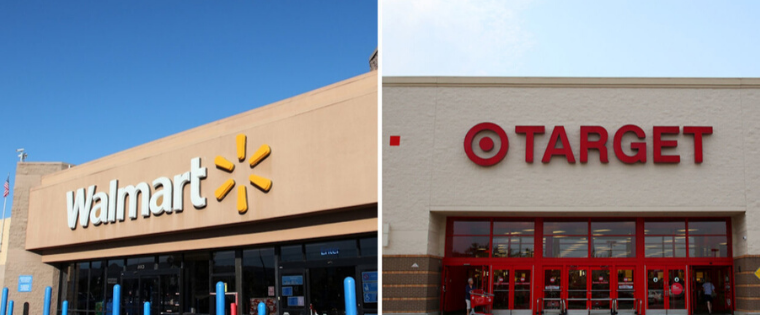
Target, Walmart Results Show Seismic Changes in Their Business
Powerhouse U.S. mass merchants Walmart and Target this week both reported results for their first pandemic-driven quarters, and the numbers show how seismic the impact has been on the shape of their businesses. Both showed sharp gains in total revenue, but also a spike in operating costs and lower gross margins as sales trends swung wildly throughout the quarter.
Target’s same-store sales rose 10.8%. Store traffic declined 1.5% from a year earlier, but the average sale jumped 12.5%. At Walmart, same-store sales for all its operations (including, for example, Sam’s) rose 10% as the average sale rose 16.5%, but the number of transactions fell 5.6%. The bottom line for both: fewer store visits, but with larger tickets.
A few other details:
Ecommerce
Ecommerce same-store sales soared at both retailers – 74% at Walmart and 141% at Target.
Target’s eCommerce sales rose 141% during the quarter (By comparison, five million customers made their first ecommerce purchase from Target in Q1 and unit volume for consumer pick-up of online orders grew 600%, including 1,000% in April, said CEO Brian Cornell. Target’s same-store ecommerce business, which increased 33% in February, rose 100% in March and 282% in April.
The number of consumers using Walmart’s buy online, pick-up at store service has quadrupled since mid-March and the service’s unit volume increased nearly 300% in April, Walmart CEO Doug McMillion said. Walmart also doubled the number of stores with an express delivery option (two hours or less) to 2,000 locations by June.
Apparel
Target reported a steep decline in apparel. Sales in the category were down 50% in late March, before regaining some footing in mid-April and finishing with a 20% decrease. Walmart’s apparel sales declined 14% in Q1.
The first four weeks after the COVID-19 outbreak in the U.S. were “pretty doom and gloom [in apparel] and most of my conversations with Walmart and Target were about shifting things and re-looking at open to buys and making sure they were doing every possible thing to eliminate a buildup of inventory,” one supplier told us. “And then, right before Easter, the weather hit and people started receiving government stimulus checks [on April 15]. We had multiple apparel styles and I’ve never before seen SKUs sell at the rate they did.”
Other categories
“Among our five core merchandising categories,” said Target‘s Cornell, “we saw the strongest performance in Hardlines, which grew comparable sales by well over 20%. Growth was particularly strong in electronics, where comps grew more than 45%, reflecting high demand for video games and home office items.
“Essentials and Beauty saw high-teen comp growth, while comps in Food and Beverage grew by more than 20%.”
Inventories
Walmart and Target reported being out of stock in multiple categories of essential products during the quarter, but returned to more typical inventory levels by late April. But electronics and home office products are expected to be in short supply until new shipments from the Far East arrive in June and July, Walmart CEO Doug McMillon said this week. Target’s inventory declined 8% in Q1 ended April 30, Cornell said. Inventory at Walmart finished down 6%.
Pricing
With inventory expected to flood the market as previously closed retailers re-open, Target will “continue to be priced right” after having taken a $300 million merchandise write-down in Q1 that was largely tied to apparel, Cornell said. For its part, Walmart has “price investments” planned for later in the year, but for the time being is focusing on filling out of stock categories, Walmart U.S. CEO John Furner said. Walmart maintained its everyday low price “discipline” in Q1, he said.

















